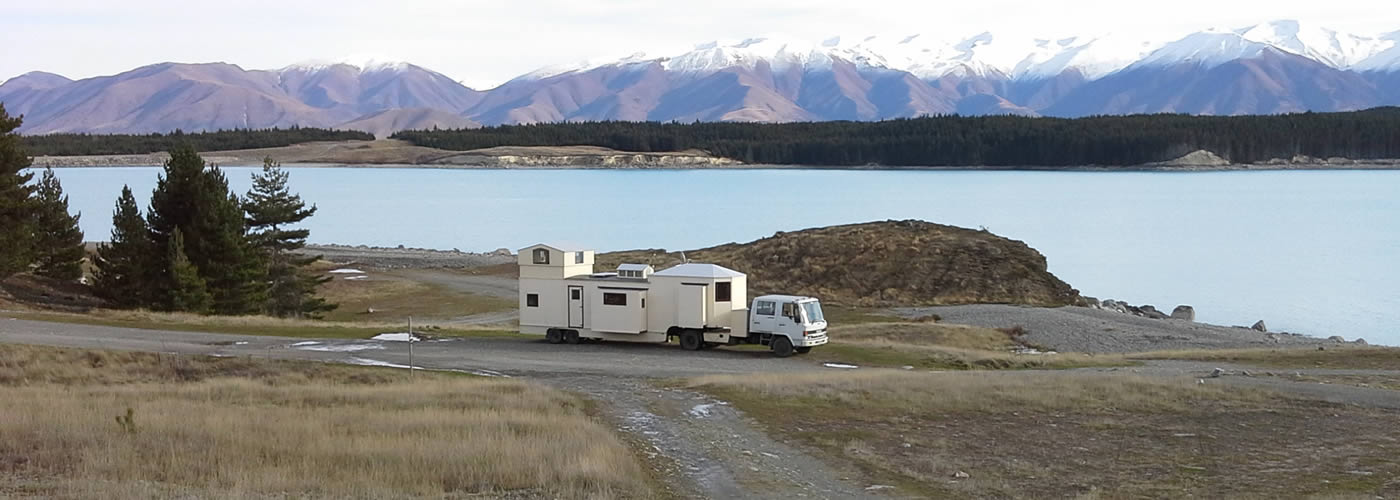
About the Little Honey – Started in a housetruck
Based in the Southern Rangitikei, I have been making Little Honey wood burners as a hobby for the past 25 years. I’m a semi retired agricultural contractor, farmer, housetruck builder, amateur engineer and general machinery fixer upper. Thanks to Christine, my wife of 38 years, I’m also the proud father of 4, and grand father of 10.
It all started 25 years ago, after nearly freezing my family to death in our first housetruck trip down the South Island in the winter. I came home and stuck my head inside the log burner in our house, to see how it worked, picked the brains of a friend who rebuilt wood burners for a living and went to work.
What housetruckers needed was a small wood stove that wasn’t big or heavy, one you could cook on and control the heat, see inside with glass in the door, was safe to use in a confined space (ash or coal catcher and heat shields), could be shut down quickly when it was time to move on, and would burn OVER NIGHT. The Little Honey does the lot!
– Melly
Recent Customer Feedback
We recently installed the “Little Honey Woodburner” you supplied in October, and are very impressed. The woodburner lives up to its name indeed! Very well designed, manufactured, packaged, delivered…. and its performance is excellent!!!…….thank you!
Frequently Asked Questions
(Click on the FAQ titles below to see the answers)
Do you have Little Honey Woodburners in stock?
Not usually. Because of the demand and customizing options, Little Honeys are made to order. There is usually a waiting list, so please inquire for wait times.
Payment will be required before manufacturing begins of your Little Honey.
Can a Little Honey be installed in a permanent dwelling?
They are most frequently used in motor homes, house trucks, buses, camper vans, boats and the latest trend is to use them as a small wood stove in a Tiny House.
As an ‘untested fire’ the Little Honey is intended only to be installed in movable accommodation where a permit is NOT required and they do not have to be clean air approved. Correct installation and safe operation is the buyer’s responsibility.
What are the recommended clearances for installation?
Can you fit a wetback to a Little Honey Woodburner?
We don’t recommend that a wet back is fitted to the interior of the firebox, as it tends to lower the temperature and will hinder the double burning process.
COMING SOON! – ‘LITTLE HONEY’ HOT WATER JACKET.
Can you burn drift wood?
We do, but only native timber or hard woods, as they are usually dry even in winter and won’t have soaked up much salt water. What is essential though is that the flue is fitted with a hat that will prevent any rain to go down it. Water + salt = RUST!
How much do they weigh?
How thick is the steel?
Where can I get the flue (chimney)?
The Little Honeys take the standard 100mm flue. We now supply flue components and flue kits. Please contact for options & pricing.
Does it burn coal?
Do you do installations?
What are the freight/shipping costs?
The shipping varies from $130 to $160 depending on where in New Zealand it is going to. We’re based in the Southern Rangitikei, (Lower/middle North Island), so the closer you are to us, the cheaper the shipping will be. (Freight quotes are only available to your nearest main centre, and rural delivery is not recommended.)
We don’t currently ship overseas, but we may be able to work something out if you get in touch with us. See Contact Details here.
Does the Little Honey have fire bricks?
I have given this some thought. As the prime purpose of fire bricks is to protect the steel from warping and splitting from extreme heat, I have decided that it was not necessary. The Little Honey is designed as a small, slow burner and should not get so hot that it glows red. The area that gets the hottest, above the double burner plate, is made of 6mm steel.
The steel fins, that the heat shields are bolted to, are to strengthen the sides and conduct heat away from them. If it proved to be a problem I would weld extra fins on before I reduced the size of an already small combustion chamber with bricks.
Will a wood burner deplete the oxygen level in my motor home or tiny house?
No! During normal operation of the fire, the only oxygen that is used is in the air that is actually drawn into the woodburner through the air vents and is consumed inside the firebox. The resulting fumes are vented entirely and safely to the outside through the flue. This small amount of air used will be immediately replaced from the outside through any hole or gap in the shell of the building. In the unlikely case of a completely sealed room, the fire would be hard to keep going or even light as no draft could be created, through the air vents, by the flue.
In actual fact, a woodburner ensures the circulation of air in a building, something that is needed for lowering condensation and ensuring fresh air for respiration, particularly at night.
The only time there could be any problem is if the airflow is somehow reversed and smoke comes out the air vent as fresh air is sucked into the woodburner through the flue. This can sometimes happen in windy weather, when the air pressure outside can fluctuate momentarily, causing a puff of smoke to come out the air vent, or if the door of the motorhome is opened out suddenly, or an expelair over the stove or in the bathroom may lower the air pressure enough to neutralise or reverse the air flow in the flue.
To compensate for this, ensure the flue is at least 1.5 mtrs long. Make sure there is somewhere for air to enter your motor home etc. to at least match the flow of air up the flue or through your expelair. (In the floor, not exposed directly to the wind, is better than a roof vent or an open window where your warm air can just escape).
Remember to clean your flue occasionally.
AND you already have a smoke alarm fitted, haven’t you!!!
Can I get new handles or knobs if I need them?
Yes, I can supply a new set for a nominal charge of $50 including postage; or for free, if they fail within the first 12 months.
Can I get the glass replaced?
Yes. The best is to just send me the door, as the glass is welded in place and not easily replaced by someone who doesn’t have the parts required. I have only had to do it once!

